Chaco has released a limited run of camouflage sandals.
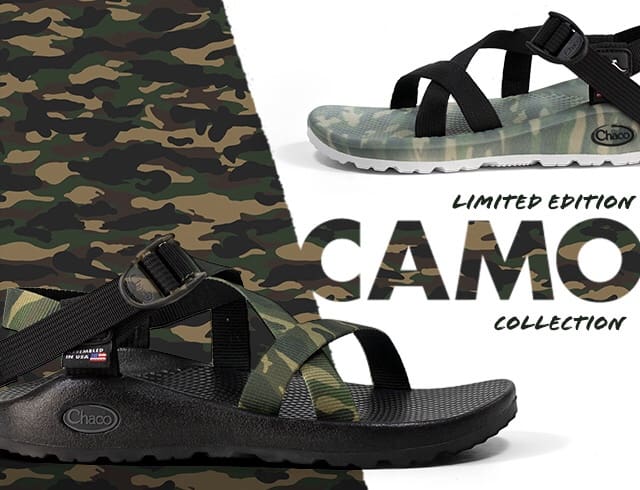
There are several styles available but they’re a limited run. The patterns are woodlandesque, but make the point.
www.chacos.com/US/en/limited-edition-collections
Chaco has released a limited run of camouflage sandals.

There are several styles available but they’re a limited run. The patterns are woodlandesque, but make the point.
www.chacos.com/US/en/limited-edition-collections
A few weeks ago, as my wife and I were working our way back home south from some vacation time in the north woods. We spent a couple of days with my oldest son who runs his very successful business out of lower Manhattan in NYC, (Snack Crate Inc, if you’re interested). Mostly, we did the tourist thing, visiting the WTC Memorial, eating a fantastic lunch in China Town, shopping, etc. The weather was perfect and we had a great day walking everywhere, (almost 8 miles by my wife’s Fit Bit). A great time overall and quite the contrast to the quiet pine covered mountains we had spent the last week in.
At one point my wife needed to use the bathroom, so we decided to duck into a McDonald’s. As usual the line to the women’s room was long and slow, so as I was waiting for her, I did my usual scanning the area to see what was up. It was a huge place with at least a 100 people crowded in there. Mostly families with kids and groups of teenagers and tourists visiting the city is what I gathered. Then, out of the corner of my eye I caught something that looked out of place. Near the back of the line to the ladies’ room was a small group of what I knew instantly to be Amish women. Not hard to figure, as they were dressed in the traditional clothes that they are well known for.
Plus, I know Amish people, as they have large communities up north where I’m from, but I had never seen them in a fast food place? I then noticed a group of Amish men standing near the doorway and I guessed they were waiting for the women. As none of them were seated, eating or carrying bags of food. My guess was like us, they only came in to make a head call. The must have been on a tour, or just visiting the city? I then noticed that in the line with the Amish women were at least half a dozen young kids between the ages of 5-10 years old. Both boys and girls, all dressed in Amish attire.
However, what really stood out about these kids was that all of them were thin and very healthy looking. One little girl of about 7-8 was nearest too me and she seemed to be literally glowing with health in her little freckled, sun kissed face. The women themselves (other than one women who seemed to be in her 70’s) were all tall, slim and athletic looking. Not being racial here, but as they were all mostly blond haired and fair skinned they all seemed something out if a 1930’s German propaganda film. The Amish men, with their beards and old school hats gave off a similar vibe of strength and health. Tall and rawboned looking with rough hands and sunburned faces, they stood quietly talking by the door. Their way of standing took me back to my childhood when I used to see my dad and uncles standing together at a family picnics, or when they were playing horse shoes. Men who work with their hands have a certain look, it’s a natural thing that can’t be faked or misread and I know it when I see it.
Looking at these simple quiet people, they stood in stark contrast to the rest of loud and colorfully dressed patrons around them. Unfortunately, the majority of the other kids and adults in there were far from any picture of health. Most were noticeably overweight as they worked their way happily through Happy Meals and Big Macs. This got me thinking about how these Amish were somewhat of a snap shot from the past. Not in any way about their race, religion, or ethnic background, but in their basic appearance and in the obvious state of their physical well-being.
I say this as most people know that the Amish lead a simple and traditional lifestyle, based on very strict religious beliefs that restrict them from most of the conveniences of modern life. No electricity, no machinery, no TV and certainly no computers or video games. This lifestyle also has a big influence on their diet, which is made up primarily of homegrown fruits and vegetables, their own livestock, dairy and poultry. The grow food, cure meats and prepare their meals in the most basic of methods and rarely eat out, or buy processed foods. With that, they don’t do Cross Fit, run marathons or attend spin classes. They just work. Work on farms, building furniture and other types of physical labor. It’s my understanding that all the children are expected to work and help with family chores also. Where I grew up, they’re well known for their handmade furniture, quilts, outdoor sheds, baked goods and vegetables. They are also very active generally, with a lot of walking and bicycle riding as part of their daily routine.
Curious about them, after I returned home I did some research on the Amish and I was surprised to find out a number of different health studies have been done on their community. Some of the results I discovered were surprising and some were not. Even with our over sized caloric intake as a country, the average Amish man, or women consumed more calories, (especially high fat content calories, which is mostly due to their use of full fat dairy products) than the average non-Amish. However, they had a lower body fat %. Amish children have very low rates of being overweight and their long-term health was better in almost ever respect. Though they do have some issues, as they tended not to go to doctors for any preventive care, or medicine. They also showed much better sleep patterns as they had zero exposure to our constant media world and they had much lower levels of stress related aliments. They were many other interesting findings, too many to discuss here.
In any case they are (as a community), a look back at how most of the people in this country looked decades ago. I say all this as a fitness trainer and author, because as the more I study and learn about fitness, health, diet and exercise the more I find myself looking to the past, to try and figure out a better future. Don’t get me wrong, I’m not proposing that anyone, myself included take up the Amish lifestyle to get into shape. Far from it. What I’m saying is that a diet made up of simple foods and an active lifestyle has far reaching, long term benefits as far as your health and fitness goes. Now add to that some real separation from the 24/7 media stress rodeo, better sleep and some actual exercise and IMO you couldn’t help be on the way to better health, better fitness, a healthier body weight and a less stressful day to day existence as a bonus.
In other words, while I’m not be ready to trade in my Tundra for a horse and buggy, I do feel like we can all learn something from people who supposedly are nothing more than uneducated throwbacks. Most of all that maybe in the end, getting and staying in shape is more of a by product of the right life, than the latest fitness trend, supplement, electronic monitor, or workout routine? It’s worth considering in any case.
I hope everyone reading this stays safe if you’re in the way of the incoming hurricane and are all looking forward to some cooler weather, I know I am. We’ll talk next month. Till then:
“Be safe always, be good when you can.”
Semper Fi
MGunz
AFSOC showing what it’s all about.
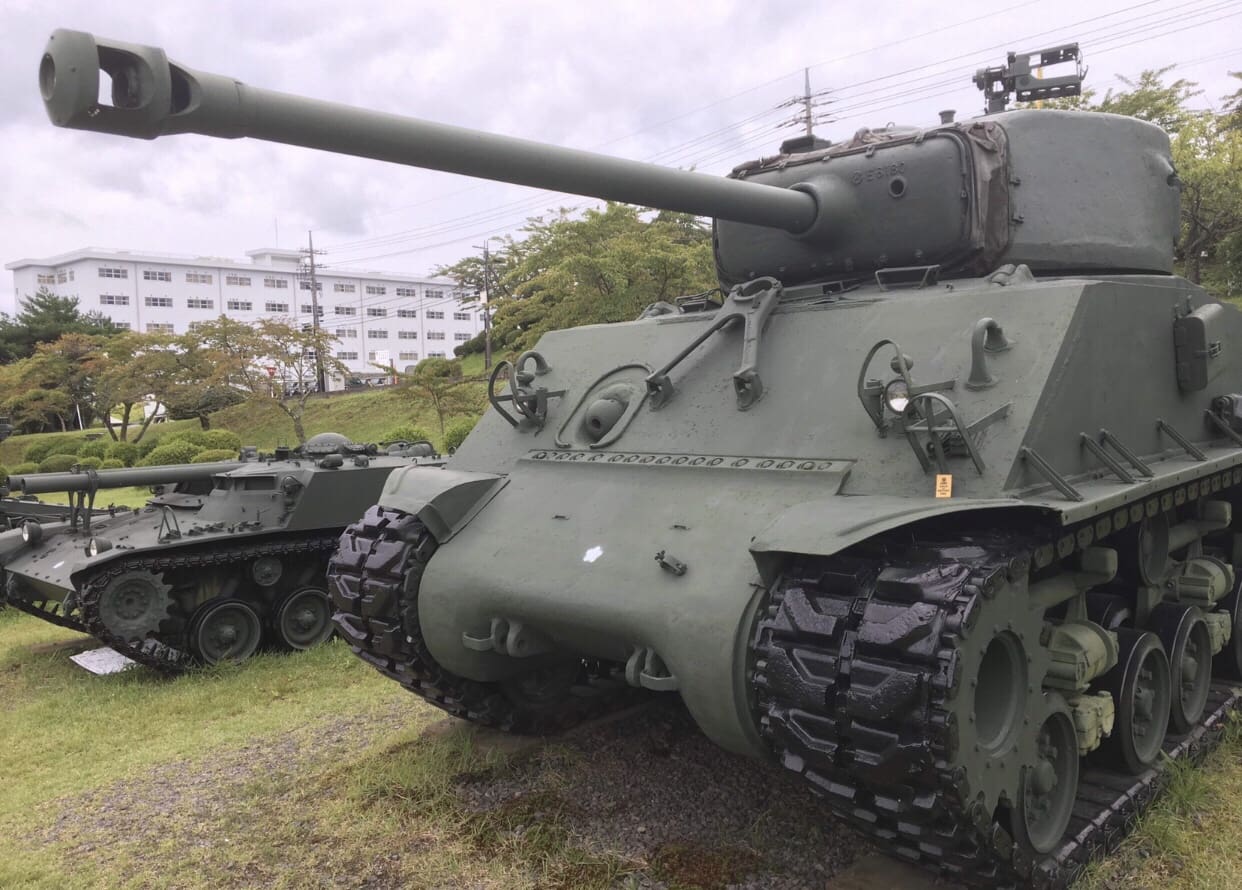
On a JSDF base.

Marine Corps Tactical Systems Support Activity
CAMP PENDLETON, Calif.— Marine Corps Tactical Systems Support Activity welcomed Vietnam veterans from Marine Air Support Squadron 3 to MCTSSA’s headquarters aboard Marine Corps Base Camp Pendleton this summer.
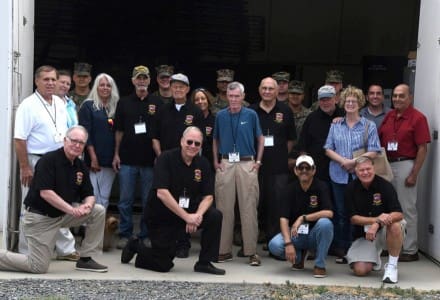
Marine Corps Tactical Systems Support Activity personnel hosted U.S. Marine Corps veterans who served with Marine Air Support Squadron 3 in Vietnam and their family members, as part of a 50th reunion tour this summer aboard MCB Camp Pendleton. (U.S. Marine Corps photo by Sky M. Laron)
MCTSSA hosted the veterans and their family members, who hail from all over the country, as part of a 50th reunion tour that took them to various units across base.
As a Vietnam-era tactical technology support organization, MCTSSA has served the Marine Corps for nearly five decades and shares an aviation support-related background with the veterans.
Established in 1970, MCTSSA was formed around the nucleus of Marine Air Control Squadron 3, with its organic Tactical Computer Programming Section, which was recognized as the first computer automation effort by the Marine Corps.
Veterans who served at various times in the Marine Air Command and Control Systems, or MACCS, in Vietnam between 1966 and 1971 primarily supported close air support of fixed wing and helicopter aircraft in either the Direct Air Support Center or Air Support Radar Team.
MCTSSA Marines and civilians spoke with these battle-tested veterans about the past, present and future of radar and overall support of operating forces.
“This tour brought back memories of the radars we used in the Marine Air Control Squadrons in the 60s and 70s,” said retired Lt. Col. Charles Manazir, former MASS-3 air support officer and participating veteran, adding that he enjoyed the tour and thought it was very informative.
Manazir had high praise for the MCTSSA Marines who briefed the group of veterans.
“The Corps is still in good hands,” said Manazir. “You are carrying on our proud Marine Corps tradition, and we salute you.”
Another veteran who attended the event was retired Col. Ken Brown. Brown served with MASS-3 in Vietnam from February 1970 until June 1971, and holds the distinction of serving as MCTSSA’s commanding officer from 1990 to 1993.
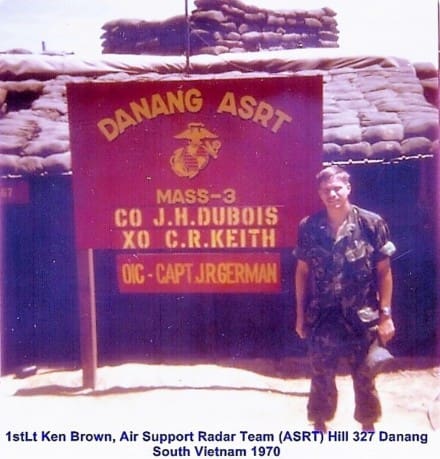
Then 1st Lt. Ken Brown poses in front of his unit in Danang, South Vietnam in 1970. Brown, a retired Marine Colonel and former Marine Corps Tactical Systems Support Activity commanding officer, was part of a group of Vietnam veterans from Marine Air Support Squadron 3 that toured MCTSSA’s headquarters aboard Marine Corps Base Camp Pendleton this summer. (Courtesy photo)
Brown said he felt proud and privileged to have been one of the “caretakers” of the MCTSSA legacy.
“MCTSSA has some of the smartest people, both Marines and civilians, in the entire Marine Corps,” said Brown. “MCTSSA is a very unique and valuable asset, capable of being a key component for ensuring our Marines continue to receive the technology and systems needed on future battlefields.”
Full-scale use of electronic data in military conflict has come a long way since Vietnam and has fundamentally changed the nature, timeliness and availability of battlefield information, with MCTSSA being a key enabler along the way.

Staff Sgt. Jedidiah Seiler, Marine Corps Tactical Systems Support Activity radar staff noncommissioned-officer-in-charge, discusses air search radar capabilities during a Vietnam veterans’ tour of MCTSSA this summer. (U.S. Marine Corps photo by Sky M. Laron)
This quantum leap in technology is even more significant, considering the state of electronic and computing technology during the late 1960s and early 1970s. The Marine Corps’ version of a standard Navy tactical computer – known as the CP-808 – was about the size of a refrigerator; radar “graphic” displays located in a Tactical Air Operations Center were enormous, immobile cathode ray tubes that presented data as simple alpha-numeric blips on the screen; and the world’s first eight-bit microprocessor – the catalyst in opening the door to the powerful, inexpensive personal computers commonly used throughout the Marine Corps today – had just been invented.
Whether providing close air support fifty years ago or enabling successful deployment of today’s command and control gear, Marines past and present deliver.
“These Marines fought for their country from Da Nang to Khe Sahn and many points in between giving the operating forces the eyes they needed to put steel on target,” said Col. Robert Bailey, MCTSSA commanding officer. “They were operating the most sophisticated military equipment of that time and five decades later, Marines are continuing to operate the most advanced systems to win the day.”
The event concluded with a group photo and many handshakes to go around.
“Thank you very much for the time you spent sharing the now and the future of Marine Corps radar advancements,” said Bruce Meachim, a participating veteran who was a sergeant during his time with MASS-3. “I was and always will be a 5961 TPQ-10 radar tech, oh yeah, and a rifleman.”
MCTSSA, the only elite full-scale laboratory facility operated by the Marine Corps, is a subordinate command of Marine Corps Systems Command. MCTSSA provides test and evaluation, engineering, and deployed technical support for Marine Corps and joint service command, control, computer, communications and intelligence systems throughout all acquisition life-cycle phases.
By Sky M. Laron, Public Affairs Officer, MCTSSA

Platinum Sponsor N-Vision Optics Will Be Exhibiting at the
2018 Albuquerque PPC and 3-Gun Championship
Sponsored by the NRA
September 24-26th
We look forward to meeting with the law enforcement community and tournament spectators.


Keene, NH – Samson Manufacturing has just released their new AK thread adapter for 9×19 and 9×39 AK-type rifles with 14 x 1 LH threaded muzzles. Constructed from 17-4 stainless or 4140 carbon steel, these adapters are designed to fit standard thread ½ x 28mm 9mm suppressors to the AK pistols hitting the market.
These will also let 9×39 shooters run subsonic ammunition through their 9mm suppressors (if rated by the suppressor manufacturer).
Samson Chief Operating Officer Tim Mulverhill explained, “These 9mm AK pistols are coming in to the country with a variety of muzzle threads. Some are 1/2×28 and can take a standard 9-mil can without an adapter, and others have the 14×1 left-hand European AK thread which requires an adapter. Sometimes both thread pitches can be seen from the same manufacturer, depending on import lot. Our adapter solves this issue for shooters with the more common 14×1 muzzle thread”.
The Samson AK thread adapter indexes on the muzzle of the barrel, which provides a more uniform and tighter lockup than cheaper versions that index on the front sight base. Mulverhill explained that, “There are so many variables in AK manufacturing as far as muzzle threading and front sight base installation – even from multiple guns in the same manufacturing lot – that the most reliable way to maintain concentricity with the bore is to index off the muzzle. Our adapter does not contact the front sight base and is not intended to, which reduces any chance of baffle strikes from poorly fitting adapters. So long as your barrel threads are concentric to the bore, our adapter will maintain that alignment with your suppressor”.
Also available for 14×1 LH to 5/8x24mm applications, Samson AK Thread Adapters can be purchased at www.samson-mfg.com and are available for immediate shipment.
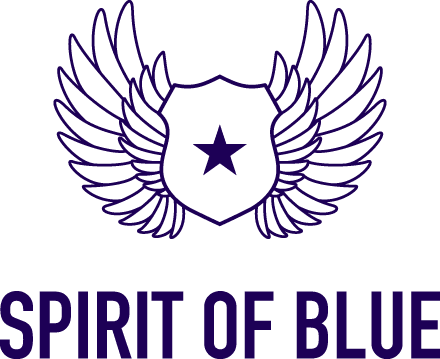
FRANKFORT, KENTUCKY – September 17, 2018 – The Spirit of Blue Foundation announced that it has awarded the Trooper Joseph Cameron Ponder Memorial Safety Grant to the Kentucky State Police Foundation (KSPF) to outfit all 1,000 troopers and officers of the Kentucky State Police with lifesaving tourniquets inside of rugged duty belt cases. The KSP uniform policy was amended to include mandatory wear of the North American Rescue Gen7 C-A-T Tourniquet inside of an Eleven 10 RIGID TQ Case with High Gloss finish and Shirt Shield attachment as part of its official uniform. Both companies worked with Spirit of Blue to configure the product specifically for KSP. The grant was funded in large part by a strategic partnership with Law Enforcement United, along with contributions from Eleven 10, North American Rescue and Sportsmen Organized for Law Enforcement, along with a number of smaller private donations, and is valued at $83,970.

(left to right) Spirit of Blue Foundation Executive Director Ryan T. Smith and Bill Janson, president of Eleven 10, LLC presented a ceremonial check for tourniquets and cases to Brenda Tiffany, mother of fallen Trooper Cameron Ponder, Kentucky State Police Commissioner Rick Sanders and Sgt. Josh Lawson, commander of the KSP Public Affairs Branch.
The grant is named after KSP Trooper Joseph Cameron Ponder, who was killed in the line of duty on Sept. 13, 2015. Trooper Ponder’s mother, Brenda Tiffany, was instrumental in the inception of this safety grant and was on hand at a special ceremony held at the Kentucky State Police Training Academy on September 13, 2018.
According to Tiffany, this memorial grant is a very fitting way to help remember her son on the third anniversary of his death. “This is the first time I have looked forward to Sept. 13th,” she said. “It’s such a positive contribution on his behalf.”
“On behalf of the Kentucky State Police, I would like to thank The Spirit of Blue Foundation for this very generous grant,” said KSP Commissioner Rick Sanders. “This grant will allow every officer to have immediate access to an effective tool which may save a life of an officer or citizen.”
Tourniquets are vital pieces of medical equipment that officers require on the road in the event of a traumatic injury to an extremity. When only precious minutes exist to treat such an injury, tourniquets are able to be applied individually or on a fellow officer to prevent excessive blood loss until that individual can be placed into medical care. As a secondary benefit, officers who carry a tourniquet are also able to use them to rescue a member of the community who may have experienced a similar type of injury.
“Tourniquets are quickly becoming one of our most granted pieces of equipment,” explained Ryan T. Smith, Executive Director of the Spirit of Blue Foundation. “The reason is because they are more affordable than most safety equipment and, sadly, officers need this type of lifesaving device more as threats to their lives, and others, become more prevalent.”
To date, Spirit of Blue has granted 2,196 tourniquets nationwide and five documented Community Saves have been made as a result.
Law Enforcement United (LEU), the grant’s sponsor, is an organization of 1,000 active and retired police officers who honor fallen officers and raise funds to assist charitable organizations that serve the law enforcement community. Each year members of the organization ride 250 miles or more into Washington, DC to participate in National Police Week events and carry flags in honor of each fallen officer which are given to the surviving families upon their arrival. Since its founding in 2009, LEU has raised over $5,750,000 for law enforcement causes.
Statistics released by the Officer Down Memorial Page show that 105 law enforcement officers have already lost their lives in 2018 – a 5% increase over the same period in the year previous. 40 of those deaths were firearm related, an 18% increase over the same period in 2017. The reality of these statistics, and the increasing number of underfunded law enforcement agencies across the country, fuel the Spirit of Blue safety grant initiative.
The Spirit of Blue Foundation actively encourages the public at large to honor and appreciate law enforcement officers who serve and protect our communities. By supporting the Spirit of Blue Foundation, the public can make an impact in the lives of law enforcement officers every day. To learn more about the Spirit of Blue, or make a donation, visit www.spiritofblue.org.